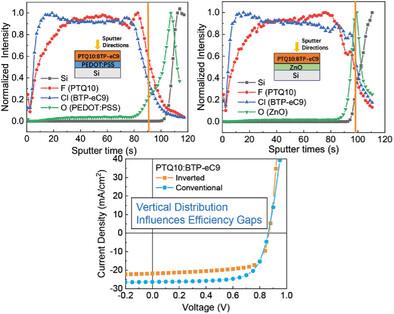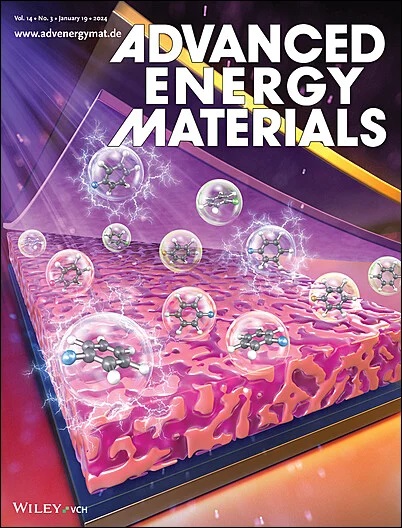Control Over Vertical Composition in Low Complexity Polymer Solar Cells
IF 26
1区 材料科学
Q1 CHEMISTRY, PHYSICAL
引用次数: 0
Abstract
Inverted organic solar cells are promising due to their better stability compared to conventional structures. Donors with low synthetic complexity are desirable to lower costs. However, inverted devices are rarely used in low-complexity systems. To investigate the reasons, the low-complexity PTQ10:BTP-eC9 binary system is benchmarked against the high-complexity PM6:BTP-eC9 system. In PTQ10:BTP-eC9, where the efficiency of inverted devices lags the conventional structure significantly, distinct wetting layers are observed in conventional and inverted device structures. Conversely, the vertical distribution of PM6:BTP-eC9 remains unaffected by changes in interlayer materials. The surface is always enriched in BTP-eC9, but less for PM6. Importantly, the addition of PC71 BM reduces the nonuniform vertical composition gradients. As the PC71 BM concentration increases, the efficiency of the inverted PTQ10 devices approach that of the conventional devices and PTQ10:BTP-eC9:PC71 BM (1:1.2:0.4) exhibits negligible efficiency differences between inverted (14.01%) and conventional (14.49%) architectures. The concentration-gradients aredriven by the interfacial energy between the active layer and interlayer materials and the casting kinetics in the case of the surface. Understanding the thermodynamic and kinetic aspects provides valuable insights for optimizing the performance of inverted organic solar cells, bringing them closer to practical applications.

低复杂性聚合物太阳能电池的垂直组成控制
与传统结构相比,倒置有机太阳能电池具有更好的稳定性,因此前景广阔。合成复杂性低的供体是降低成本的理想选择。然而,倒置装置在低复杂度系统中很少使用。为了研究原因,将低复杂度的PTQ10: bp - ec9二进制系统与高复杂度的PM6: bp - ec9系统进行了基准测试。在PTQ10:BTP-eC9中,倒置器件的效率明显落后于常规结构,在常规和倒置器件结构中观察到明显的润湿层。相反,PM6:BTP-eC9的垂直分布不受层间材料变化的影响。表面总富集BTP-eC9,而较少富集PM6。重要的是,PC71 BM的加入减少了不均匀的垂直成分梯度。随着PC71 - BM浓度的增加,倒置PTQ10器件的效率接近常规器件,而PTQ10:BTP-eC9:PC71 - BM(1:12 .2:0.4)在倒置(14.01%)和常规(14.49%)架构之间的效率差异可以忽略。浓度梯度是由活性层和层间材料之间的界面能和表面的铸造动力学驱动的。了解热力学和动力学方面为优化倒置有机太阳能电池的性能提供了有价值的见解,使其更接近实际应用。
本文章由计算机程序翻译,如有差异,请以英文原文为准。
求助全文
约1分钟内获得全文
求助全文
来源期刊

Advanced Energy Materials
CHEMISTRY, PHYSICAL-ENERGY & FUELS
CiteScore
41.90
自引率
4.00%
发文量
889
审稿时长
1.4 months
期刊介绍:
Established in 2011, Advanced Energy Materials is an international, interdisciplinary, English-language journal that focuses on materials used in energy harvesting, conversion, and storage. It is regarded as a top-quality journal alongside Advanced Materials, Advanced Functional Materials, and Small.
With a 2022 Impact Factor of 27.8, Advanced Energy Materials is considered a prime source for the best energy-related research. The journal covers a wide range of topics in energy-related research, including organic and inorganic photovoltaics, batteries and supercapacitors, fuel cells, hydrogen generation and storage, thermoelectrics, water splitting and photocatalysis, solar fuels and thermosolar power, magnetocalorics, and piezoelectronics.
The readership of Advanced Energy Materials includes materials scientists, chemists, physicists, and engineers in both academia and industry. The journal is indexed in various databases and collections, such as Advanced Technologies & Aerospace Database, FIZ Karlsruhe, INSPEC (IET), Science Citation Index Expanded, Technology Collection, and Web of Science, among others.
 求助内容:
求助内容: 应助结果提醒方式:
应助结果提醒方式:


